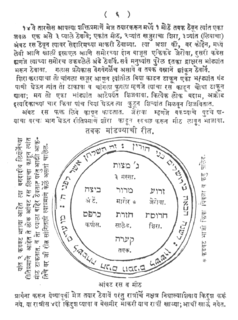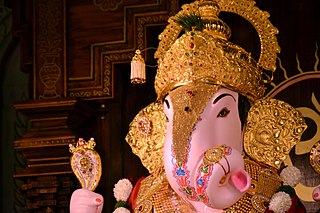
Marathi is an Indo-Aryan language spoken predominantly by around 83 million Marathi people of Maharashtra, India. It is the official language and co-official language in the Maharashtra and Goa states of Western India, respectively, and is one of the 22 scheduled languages of India. There were 83 million speakers in 2011; Marathi ranks 19th in the list of most spoken languages in the world. Marathi has the third largest number of native speakers in India, after Hindi and Bengali. Marathi has some of the oldest literature of all modern Indian languages, dating from about 900 AD. The major dialects of Marathi are Standard Marathi and the Varhadi dialect. Koli, Malvani Konkani has been heavily influenced by Marathi varieties.
Mumbai Hindi, also known as Mumbaiya Hindi, Bambaiyya, Mumbaiyya, or Mumbai Hindi-Urdu, is the variety of Hindi-Urdu (oman) spoken in Mumbai, India. The dialect incorporates words and pronunciations mainly from Hindi and Urdu, collectively known as Hindi-Urdu, or Hindustani. In addition, the predominant substratum influence on Bombay is Marathi, reflecting Mumbai's location in a wider Marathi-speaking area, Maharashtra. Bombay Hindi also has elements of Gujarati, and Konkani.
Marathi literature is the body of literature of Marathi, an Indo-Aryan language spoken mainly in the Indian state of Maharashtra and written in the Devanagari script.

Maharashtra Times, colloquially referred to as 'Ma Taa' (मटा) from its Marathi initialism, is a Marathi newspaper based in Mumbai, India. It is the ninth-largest-selling daily newspaper in the country.

Judeo-Marathi is a form of Marathi spoken by the Bene Israel, a Jewish ethnic group that developed a unique identity in India and in Pakistan. Judæo-Marathi is, like other Marathi, written in the Devanagari script. It may not be sufficiently different from Marathi as to constitute a distinct language, although it is characterized by a number of loanwords from Hebrew and Aramaic as a result of influence from the Cochin Jewish community, Judæo-Malayalam and Portuguese and also some influence from the Urdu language. It has some linguistic features in common with various Jewish languages, developed by Jewish communities in widely disparate places in times, which are also variants of a local language with loanwords from Hebrew and Aramaic.
Budhwar or Badhwar is a surname commonly used by jats. However there are a few exceptions among the punjabis including sikhs. These are mainly originated from Haryana few of them settled in Uttar Pradesh and Rajasthan.
The Marathi people or Maharashtrians are an ethnolinguistic group who speak Marathi, an Indo-Aryan language as their native language. They inhabit the state of Maharashtra as well as districts bordering the state, such as Belgaum and Karwar of Karnataka and the state of Goa in western India. Their language, Marathi, is part of the of Indo-Aryan language family. It is to be noted that the term 'Maratha' by historians, is at times used to refer to all Marathi speaking people, irrespective of caste and at times to a Maharashtrian caste called Maratha. The Marathi community came into political prominence in the 17th century when Maratha warriors, under Chhatrapati Shivaji Maharaj, established the Maratha Empire, which is credited to a large extent for ending the Mughal rule. All Marathi people are at times pejoratively called Ghati by immigrants to Maharashtra, and specifically to Mumbai, from other areas of India.

Budhwar Peth is one of many commercial localities in the old city of Pune, India. The area has a high number of electronics shops and materials, also its famous as love area and the heart of the city. Three out of the five important ganesh mandals i.e. Jogeshwari Ganpati, Guruji Talim Mandal, Tulshibaug Ganpati are located here, as is Appa Balwant Chowk, known as ABC, which is a crossroads famous for its bookshops and popular with students.
The main attraction of Budhwar Peth is Shrimant Dagdusheth Halwai Ganpati.

Marathi cinema refers to Indian films produced in Marathi, the language of the state of Maharashtra, India. Based in old Mumbai, it is the oldest and one of the pioneer film industries of India. The first Marathi film to be released in India was Shree Pundalik by Dadasaheb Torne on 18 May 1912 at Coronation Cinematograph, Mumbai. and a Marathi crew who were performing Marathi and Sanskrit Sangeet natikas (musicals) and plays in Marathi at that period. The first Marathi talkie film, Ayodhyecha Raja, was released in 1932, just one year after Alam Ara the first Hindi talkie. Although the industry is much smaller than the large market driven Hindi cinema based in Mumbai, Marathi cinema is tax free, and is experiencing growth in recent years. Raja Harishchandra, directed by Dadasaheb Phalke, was a Marathi film, now known as India's first full-length feature, released in 1913. The Dadasaheb Phalke Award is India's highest award in cinema given annually by the Government of Maharashtra for lifetime contribution to Indian cinema.

Shreemant Dagdusheth Halwai Ganapati Temple in Pune is dedicated to the Hindu God Ganesh. The temple is popular in Maharashtra and is visited by thousands of pilgrims every year. Devotees of the temple include celebrities and Chief Ministers of Maharashtra who visit during the annual ten-day Ganeshotsav festival. The main Ganesh idol is insured for sum of ₹10 million (US$140,000). People are celebrating 125 years of celebration for this Ganapati in the year 2017.
Shree Shiva Chhatrapati Market Yard, locally called as Market Yard is one of the popular marketplaces in Pune city. It is located near Gultekdi in Maharshi Nagar area. It is near to Swargate, which is an important commercial area in Pune. It is famous as fruits, vegetables, flowers, and wholesale market.
Dr. Datta Walvekar was an Indian Marathi singer and Music Director
Bābu Genu Said (Said) was an Indian freedom fighter, a revolutionary.
Mahatma Phule is a 1954 Marathi film directed by Pralhad Keshav Atre. The film is based on the life of social reformer and activist Jyotirao Govindrao Phule.

The Marathi Wikipedia is the Marathi language edition of Wikipedia, a free and publicly editable online encyclopedia, and was launched on 1 May 2003. The project is one of the leading Wikipedia among other South Asian language Wikipedia's in various quality matrices. It has grown on to become a Wiki containing more than 51,326 articles and has more than 88,175 registered users.
Shaniwar Peth is a general term in the Marathi language for a locality in the Indian cities. These include cities like Pune, Solapur, Madhavnagar, Karad, and Ahmednagar. The term Shaniwar has derived from the day Saturday in Marathi.
Vasant Cinema is the oldest Theater in central Pune located near Budhwar Peth and Shanivar-wada. The theater began in early 90's as a Marathi theatre for drama where famous artists such as Bal Gandharva and many more performed. Now Vasant Cinema plays movies of Bollywood and Marathi movies are screened.
The term Marathi Muslims is usually used to signify Marathi Muslims from the state of Maharashtra in North-western coast of India, who speak Marathi as a mother-tongue and follows certain customs different from the rest of Indian Muslims. Marathi Muslims are very prominent in industry and medium-sized businesses. Many members of this community migrated to Pakistan in 1947 and have settled in Karachi & other parts of Sindh, contributing greatly to the general welfare and economy of Pakistan.
Sanjay Budhwar is an Indian first-class cricketer who plays for Haryana.








